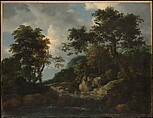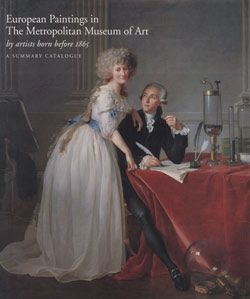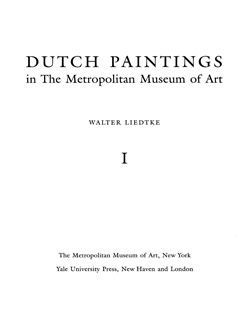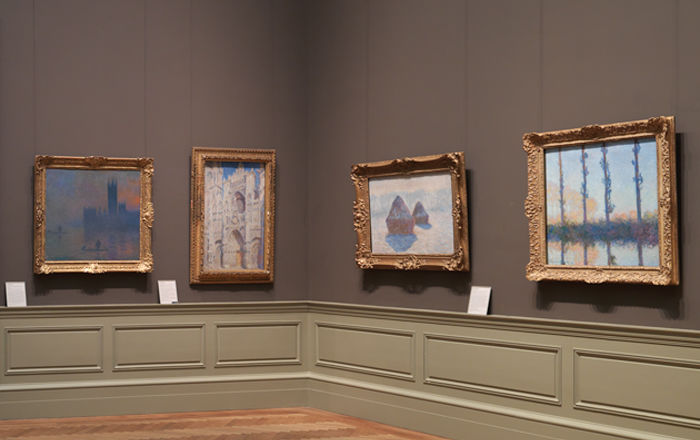Ruisdael's wooded landscapes of the 1650s and 1660s are remarkable for their rich patterns of textures and colors, seen here in the deep browns and greens that predominate in this canvas of about 1660. The blues of the water and the lighter greens and reddish browns of the rocks in the center effect a gradual transition from the shadowy foreground to the sunlit cliffs in the right background and the rosy clouds in the brightest area of a mostly blue sky. On the grassy hill in the background, sheep are herded by three figures—clearly a family—a man, a woman on a donkey or pony, and a boy.
The painting demonstrates the artist's mastery of composition and his sensitivity to mood. The view is framed by groups of trees that have weathered many seasons, much as the rugged hills, the massive boulders, and the descending stream suggest a geological history more varied than the one traceable in the area of Amsterdam. Ruisdael's customary placement of ordinary figures in such a setting shifts the emphasis from the dramatic to the picturesque, for while his landscapes vary considerably within this range, they were always made accessible to the inhabitants of the domestic world for whom they were intended. The 1660s, in Dutch painting and especially in the art world of Amsterdam, could be described, for the most part, as a period of calm seas, country houses, and Mediterranean vistas. One has the impression that the Dutch burgher would let his imagination run to distant places so long as he was sure of returning home.
This type of landscape, with rocky hills, expansive trees, and a flowing stream, is often said to have been inspired by the Scandinavian views of Allart van Everdingen (1621–1675), who wandered through Norway and Sweden in 1644, settled in Haarlem in 1645, and in 1652 moved to Amsterdam. That Ruisdael was strongly influenced by the Alkmaar artist during the second half of the 1650s and later is clear from his usually vertical compositions that feature cascading water and distant thrusts of rock (The Met's
Mountain Torrent,
25.110.18, is a late and comparatively tame example, once thought to be by Everdingen himself). Here, however, only the rocks, with their broad strokes of siena, have much to do with Everdingen; the composition as a whole is consistent with Ruisdael's landscapes of the early to mid-1650s, which follow upon his trip to Westphalia. The way the trees fill the composition is also reminiscent of forest views painted by earlier artists, mostly Flemings active in the area of Amsterdam, such as Gillis van Coninxloo (1544–1606/7), David Vinckboons, Alexander Keirincx (1600–1652), and especially Roelant Savery (1576–1639), whose twisted trees and shady pools are often cited as antecedents of Ruisdael's woodland views, for example, the celebrated
Marsh in a Forest, of about 1665 (Hermitage, Saint Petersburg). These various influences were combined by the artist and transformed by his distinctive response to nature. Paintings like The Met’s canvas are at once the outgrowth of a long development in Dutch art and landscapes never seen until they took shape in Ruisdael's fertile imagination.
[2016; adapted from Liedtke 2007]



